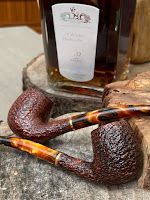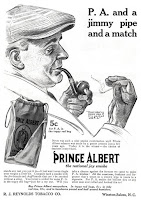The era of Prohibition (1920-1933) is often remembered for speakeasies, bootleggers, and the rise of organized crime, but one lesser-discussed impact of the alcohol ban was its effect on pipe smoking and the tobacco industry. While alcohol was driven underground, tobacco—especially pipe smoking—saw some interesting shifts in popularity, production, and cultural significance.
During Prohibition, pipe smoking evolved from a casual habit into a symbol of refinement and rebellion, serving as both a substitute for alcohol and a fixture in clandestine drinking circles. Let’s take a closer look at how this tumultuous period shaped pipe smoking habits and changed the tobacco industry in ways that are still felt today.
1. The Decline of the Smoking Lounge and the Rise of Private Pipe Clubs
Before Prohibition, tobacco and alcohol were natural companions, enjoyed together in gentlemen’s clubs, saloons, and cigar lounges. These establishments often catered to pipe smokers, providing well-stocked humidors, plush smoking rooms, and an air of camaraderie where men could unwind with a drink and a pipe.
However, once Prohibition shut down bars and social clubs that served alcohol, these traditional smoking spaces began to disappear. In response, many pipe smokers migrated to private pipe clubs and underground speakeasies, where smoking remained a core part of the experience.
🔸 The Rise of Secret Smoking Lounges: While bars were outlawed, private clubs provided a loophole. In major cities like Chicago and New York, secret speakeasies would stock fine tobacco alongside illicit whiskey, allowing patrons to continue their traditions—albeit under the radar.
🔸 Pipe Smoking as a Statement: For some, pipe smoking became a quiet act of defiance, a way to maintain the old rituals of leisure and discussion despite the new laws.
2. Pipe Smoking as a Substitute for Alcohol
With alcohol no longer legally available, Americans turned to other forms of relaxation—and one of the biggest beneficiaries was pipe smoking.
🔸 A "Respectable" Vice: Unlike alcohol, which was suddenly linked to criminal activity, pipe smoking was seen as an acceptable and even intellectual habit. It was a way for men to unwind after work, engage in deep conversation, or simply enjoy a quiet moment of reflection.
🔸 The Psychological Appeal: For many, the ritual of lighting, packing, and slowly puffing on a pipe became a soothing replacement for pouring a glass of whiskey. Tobacco's calming effects provided an alternative form of relaxation during a stressful and uncertain era.
🔸 Increase in Tobacco Sales: As demand for legal vices increased, the tobacco industry capitalized on Prohibition, promoting pipe smoking as an alternative indulgence. Major brands introduced new blends, specialized advertising, and even accessories to entice smokers looking for new comforts.
3. Changes in Tobacco Advertising and Marketing
The tobacco industry was quick to recognize an opportunity in Prohibition. With alcohol off the table, tobacco companies began aggressively marketing their products as the go-to pleasure for the refined gentleman.
🔸 "Drinkers Become Smokers" Campaigns: Some companies directly targeted former drinkers, suggesting that pipe smoking offered relaxation without the legal risks of alcohol. Advertisements often showed pipe-smoking men in libraries or by the fireplace, enjoying their tobacco as a more "civilized" alternative.
🔸 Rise of Aromatic Tobaccos: To appeal to both seasoned and new smokers, companies experimented with milder, sweeter blends, introducing more Cavendish-based and aromatic tobaccos that were pleasant both for smokers and bystanders.
🔸 Hollywood’s Role: As movies gained popularity, films began portraying pipe smoking as a symbol of wisdom, intellect, and distinction. Figures like Sherlock Holmes, professors, and successful businessmen were often depicted with a pipe in hand, reinforcing its prestige.
4. The Boom of the Domestic Tobacco Industry
Another consequence of Prohibition was the increased demand for American-grown tobacco.
🔸 Decline in Imported Tobacco: Before Prohibition, much of the premium tobacco smoked in the U.S. came from Europe. But with international trade disrupted and tariffs increasing, domestic tobacco farms saw a surge in demand.
🔸 The Expansion of American Tobacco Companies: With less competition from European imports, American tobacco companies like R.J. Reynolds, Philip Morris, and Liggett & Myers expanded their operations, launching new products and widening their reach.
🔸 Growth of Local Blenders and Tobacconists: Many local tobacconists saw an opportunity to experiment with custom blends, catering to the growing number of smokers looking for unique, high-quality experiences.
5. Pipe Smoking and the Speakeasy Culture
Though alcohol was outlawed, that didn’t mean people stopped drinking—they just did it in secret. And where there was illegal alcohol, there was usually tobacco smoke filling the air.
🔸 The "Gentleman’s Ritual" in Speakeasies: Many high-end speakeasies mimicked the atmosphere of pre-Prohibition gentlemen’s clubs, offering premium tobacco alongside smuggled liquor. Patrons would pair rich English blends with illicit Scotch or sip bootleg whiskey while puffing on Burley-heavy blends.
🔸 Pipe Smoking as a Cover: Some speakeasies used pipe smoking as a decoy, filling rooms with tobacco smoke to mask the scent of alcohol when law enforcement raided their establishments.
6. Post-Prohibition and the Shift Toward Cigarettes
When Prohibition ended in 1933, the habits of American smokers had already changed.
🔸 A Decline in Pipe Smoking: Many former pipe smokers who had picked up the habit as a substitute for alcohol returned to drinking, leading to a decline in new pipe smokers.
🔸 The Rise of Cigarettes: The tobacco industry, having seen massive growth, now had the infrastructure to mass-produce cigarettes at an unprecedented rate. As the pace of life quickened and smoking habits became more fast-paced, cigarettes overtook pipes as the preferred method of tobacco consumption.
🔸 The Lingering Prestige of Pipe Smoking: Though pipe smoking became less common in the post-Prohibition years, it retained its status as a sophisticated and intellectual pastime, associated with professors, writers, and deep thinkers.
Conclusion: Prohibition’s Lasting Impact on Pipe Smoking
While Prohibition is primarily remembered as an alcohol-focused movement, it had a profound impact on tobacco culture as well. During this time, pipe smoking rose in popularity, gained an air of sophistication, and found a lasting place in American culture.
Even after the repeal of Prohibition, pipe smoking remained a mark of distinction, enjoyed by those who valued tradition, relaxation, and craftsmanship. The influence of this era can still be seen today in the way pipe smoking is associated with slow, contemplative enjoyment—much like savoring a fine whiskey or aged cigar.
Though we no longer have to choose between alcohol and tobacco, pipe smokers today continue to appreciate the slow-burning pleasure that was once a vital part of the Prohibition experience.
What are your thoughts on the connection between Prohibition and pipe smoking? Have you ever paired a favorite pipe tobacco with a vintage whiskey? Share your thoughts in the comments below! 🚬🥃
















No comments:
Post a Comment